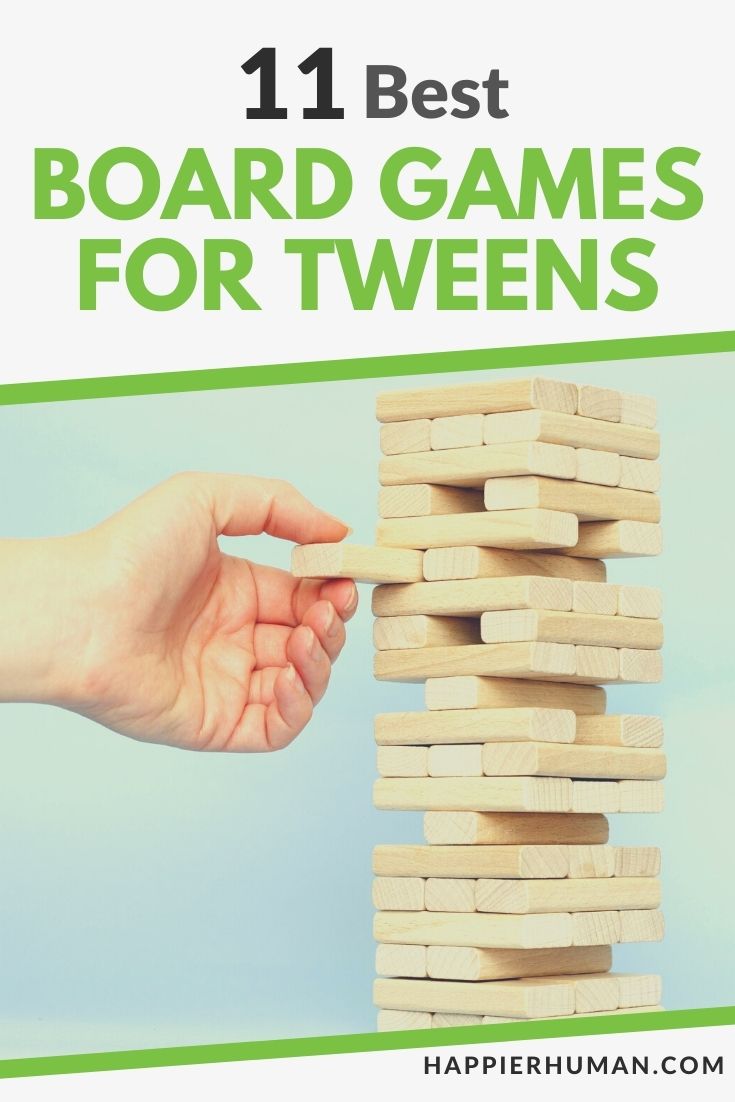There might be affiliate links on this page, which means we get a small commission of anything you buy. As an Amazon Associate we earn from qualifying purchases. Please do your own research before making any online purchase.
Are you looking for a fun, educational way to keep your tweens busy?
As a parent, it is only natural to want the best for your kids. But let’s admit it—parenting is hard and every day is an uphill battle to keep up with your kids’ expectations.
It is also important to help your growing children find alternatives to digital devices, which are taking up more and more of their time in this modern era.
Fortunately, we have a solution. If you are a parent looking for an alternative to gadgets and smartphones, then you have landed on the right page.
In this post, we discuss the 11 best board games for tweens that you can introduce to them to slowly ease their dependence on technology.
Let’s check them out!
(Side note: One of the best ways to increase your happiness and life satisfaction is to plan your day, so you focus on your TOP goals. To get started, watch this free video that details the 7-minute habit for planning your day to focus on what's important.)
What You Will Learn
1. Ticket to Ride
Ticket to Ride is one of the most popular board games out there and is featured on most “best of” lists. It is definitely a great addition to your tweens’ board games collection. The theme is traveling and geography, and there is a lot to learn from the game in addition to strategizing and decision-making.
The primary objective in this game is to match train cards, claim railway routes, and connect the cities. There are missions you need to accomplish so you can earn extra points. At the end of the game, the player with the longest route and the highest number of points is declared the winner.
This game is perfect for tweens, as it is designed for those who are eight years old and above. It can accommodate up to five players, so it is great for family game night, too. It takes around 30 to 60 minutes to finish, but you can always take your time if you want to move more slowly.
Pros
Cons
2. Monopoly
Monopoly is a classic favorite of adult game players, but it is also suitable for younger players like teens and tweens. Although there is a Monopoly Junior version for kids, we think that the original version is appropriate for your 8- to 12-year-old kids.
As you probably know, this game is all about trading, economics, and business. It revolves around the acquisition of properties like land, buildings, and money. Some of the game’s elements may be difficult to understand for tweens, so we suggest parental guidance during gameplay.
Monopoly is manufactured by game-manufacturing giant Hasbro. It is definitely worth a try if you are thinking about introducing business and economics to your young children.
Pros
Cons
3. Jenga
Jenga isn’t technically a board game, but we included it on this list because we believe that it is a rather unique way to help tweens develop their focus and concentration. It requires skill and strategy and provides a wonderful way to hone your tweens’ mental capacities.
The classic Jenga set contains 54 Jenga blocks that are strong and durable. Your goal is simple: Be the last person to remove a block without crashing the stack. If you can do this, you win.
Jenga can be played solo or with friends. There are no complicated rules to memorize, and the game is easy to set up and organize.
Pros
Cons
4. Not Parent Approved
Not Parent Approved calls itself “an inappropriately appropriate card game for mischief-makers.” It is especially intended for tweens and teens, 8 years old and above, and was designed to “provide an attention-grabbing, easy-to-learn, and hilarious alternative to screen time for children and their families.”
This game is the perfect alternative to Cards Against Humanity, as it is 100% family-friendly. The rules are the same as Cards Against Humanity: one player picks a question card and all the other players reply with their funniest answer cards. In the end, the player with the most hilarious answer wins.
Not Parent Approved has been the talk of the town since its release. It has been praised by several magazines and award-giving bodies, including The Wall Street Journal, Scholastic Gold Star Toy Award, and The Today Show.
Pros
Cons
5. Catan
Catan is another board game that always makes its way onto “best games” lists. It is a classic and has been around for many years now. A lot of expert gamers recommend it, especially to younger players or beginning gamers.
Catan is a civilization game that revolves around trading, building, and settling. It is a unique and fun way to learn leadership and business concepts. If your children are showing interest in entrepreneurship and development, then this game might be a good choice.
Catan is best played by three to four players. It is appropriate for children as young as 10 years old, since its rules are easy and simple to understand. It will help teach planning and strategizing skills and is lots of fun!
Pros
Cons
6. Telestrations
If you are looking for a game that will your tweens laugh out loud, then you are in for a treat. Telestrations is a party game that can turn even the most depressing scenes into hilarious ones. It is fun and entertaining, and definitely worth a try!
The goal of the game is simple: You just have to guess what has been drawn by your co-players. What makes it rather amusing is the hilarious miscommunications between each participant once the drawings and answers are revealed. This game works the same way as the classic telephone game, except that it also involved drawing, which makes it even funnier.
Telestrations does not require you to be a good strategist or expert board game player. You don’t even have to be good at drawing to participate. In fact, the worse you are at drawing, the funnier it will be! Either way, it is an excellent choice for your tweens.
Pros
Cons
7. Qwirkle
If your tweens are fond of dominos and Scrabble, then Qwirkle is the game for them. The goal in this game is simple: to connect lines and fill tiles by matching the blocks based on color or shape. The more complex your design is, the better.
The scoring depends on how well you match the colors or shapes. If you want a higher score, you need to make sure that you create multiple pieces that are connected by the same features. And if you want to score a “Qwirkle,” you need to create a line that has all six shapes or colors.
The game is fast-paced but requires strategy and planning. Players report that it usually takes around 45 minutes to an hour to finish. Once you get used to it, it will probably only take around 30 minutes. The game is appropriate for players who are six years old and above.
Pros
Cons
8. Sequence
Many parents like playing Sequence with their kids because it stimulates the mind. It is also entertaining and exciting enough to keep children’s interest.
The objective of the game is rather simple: Score the most points by creating a “sequence” on the board. You use your sequence cards and wild cards to accomplish this, but the most important thing is to devise a plan that can help you place your chips on the board wisely.
While the original version of Sequence is also fun, it would probably be best to try Sequence for Kids for your tweens. The original version is designed for 12 years old and above, so it might be a little challenging.
Pros
Cons
9. Spontuneous
Your tweens are sure to love this game if they are knowledgeable about music and lyrics. You don’t technically have to be a musical genius to play, but knowing a lot of songs and having a knack for memorizing lyrics can give you an advantage.
It only takes around 30 minutes to finish the game. The gist is that everyone has to sing a song that contains the trigger words. You need not sing the whole song; as long as you can sing five words, you score points.
There is a timer for each round, and once the timer stops, all those who have sung their songs advance to the next level. If you were not able to come up with anything, then better luck next time! We think that your tweens will love this game of songs and lyrics!
Pros
Cons
10. Splendor
Splendor is a great choice if you want to teach your tweens about buying and trading items. It is a merchant game, so there is a lot to learn about business, economics, merchandising, and entrepreneurship.
Additionally, this game can teach your tweens how to develop good strategies and make wise decisions. Since trading is usually about money and negotiations, it is a great way to introduce fairness and practicality.
Pros
Cons
11. Loaded Questions
Loaded Questions is one of the many popular family-oriented games available. The game involves answering questions that can be both creative and personal. There are no right or wrong answers, so this game is basically just for entertainment and to get to know each other better.
Although the original version is suitable for all ages, there is a Junior version that might be more appealing to kids and tweens. This version contains only 200 questions, compared to the original, which has 880. Either way, both versions are super fun and will keep your tweens busy.
Loaded Questions was introduced to the world in 1997. Today, it is one of the most loved family-oriented games. It comes in a number of different versions, including Original, Junior, Adult, Party, and On-the-Go.
Pros
Cons
Conclusion
We hope that with, this list we provided, you were able to pick the best board games for your tweens. Show them that there is more to life than gadgets and smartphones and introduce them to board games!
Finally, if you want to increase your happiness and life satisfaction, then watch this free video that details the 7-minute habit for planning your day to focus on what's important.













